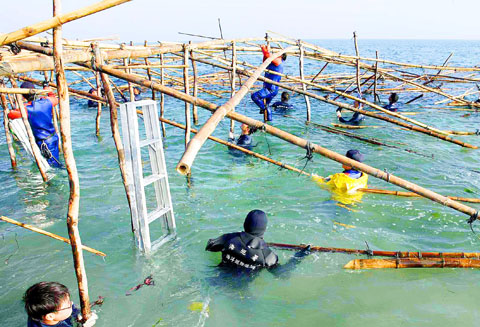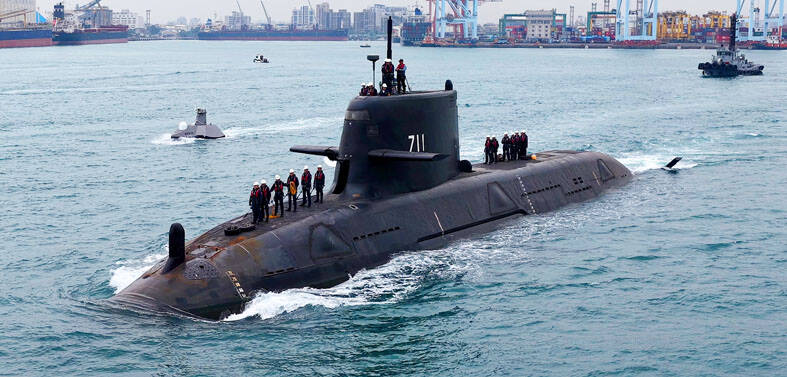Chinese fishermen have been accused of poaching in Taiwan’s first marine national park, where authorities say their destructive methods are endangering the area’s ecology.
“Chinese fishing boats have been posing the gravest threat to the fragile ecological system here,” said Shaw I-pung (蕭一鵬) of the Marine National Park headquarters, speaking of the tiny coral atoll called Dongsha Island.
“They have been using illegal methods like poisons, dynamite and electricity to exploit marine resources in the region,” he said.

PHOTO: AFP
The scourge of boats scouring the seabed for food destined for Hong Kong restaurants is combining with global warming as a major cause of coral reef bleaching, he said.
The Dongsha Islands, comprising Dongsha Island and two coral reefs which are submerged at high tide, straddles a strategically important sea route at the north of the South China Sea linking the Pacific and Indian oceans.
The island is a coral atoll with a land area of 2.4km². It measures 0.9km from east to west, and 2.7km from north to south.
Shaw said the unquenched appetite for Hong Kong’s famed Cantonese seafood is to blame.
“Most of the marine catches here, like fishes and lobsters, are quickly sent to Hong Kong, which touts itself as the world’s biggest living fish market,” he said.
Chinese fishermen, plus some Vietnamese, use cyanide to stun fish and catch them live for higher commercial prices, he said.
“Cabrilla can be sold for US$30 per kilo in Hong Kong and some other fish even sell for up to US$100 per kilo,” Shaw said.
Dongsha is 267km away from Hong Kong and 380km from Kaohsiung City.
“Smaller fish and corals were destroyed by the poisons, largely cyanide, which is easily available in China,” Shaw said.
However, “the destructive way of fishing has been endangering the coral reefs near Dongsha,” which Shaw described as an “ocean rain forest” and a biodiversity hot spot.
Academics found there are 264 species of coral, 556 species of fish and 140 species of bird — many of them migratory — in that area.
Taiwan’s coast guard says it has stopped 3,820 ships infiltrating the prohibited Dongsha waters since they were deployed in 2000.
Taiwan withdrew its Marines from Dongsha in 2000 in what the government said was a move to help alleviate tensions in the South China Sea.
Currently there are around 200 coast guard personnel are stationed on Dongsha and armed with a fleet of six patrol boats — three 10-tonne vessels and three other eight-tonne boats. There are no civilian inhabitants.
But the fleet is apparently not strong enough to serve as a “deterrent” to the Chinese and Vietnamese invaders.
“They often come back after we leave,” a coast guard officer said on condition of anonymity.
The government is now building the first permanent pier on the island to house the three incoming 20-tonne boats.
“Bigger ships would help us battle invaders as they increase our cruising capability,” said Liu Kuo-lieh (劉國列), the Dongsha coast guard commander.
As part of its ocean conservation efforts, the government inaugurated the Dongsha Marine National Park in January last year. The park administration is centered on the monitoring and conservation of the local ecology.

US climber Alex Honnold is to attempt to scale Taipei 101 without a rope and harness in a live Netflix special on Jan. 24, the streaming platform announced on Wednesday. Accounting for the time difference, the two-hour broadcast of Honnold’s climb, called Skyscraper Live, is to air on Jan. 23 in the US, Netflix said in a statement. Honnold, 40, was the first person ever to free solo climb the 900m El Capitan rock formation in Yosemite National Park — a feat that was recorded and later made into the 2018 documentary film Free Solo. Netflix previewed Skyscraper Live in October, after videos

NUMBERS IMBALANCE: More than 4 million Taiwanese have visited China this year, while only about half a million Chinese have visited here Beijing has yet to respond to Taiwan’s requests for negotiation over matters related to the recovery of cross-strait tourism, the Tourism Administration said yesterday. Taiwan’s tourism authority issued the statement after Chinese-language daily the China Times reported yesterday that the government’s policy of banning group tours to China does not stop Taiwanese from visiting the country. As of October, more than 4.2 million had traveled to China this year, exceeding last year. Beijing estimated the number of Taiwanese tourists in China could reach 4.5 million this year. By contrast, only 500,000 Chinese tourists are expected in Taiwan, the report said. The report

Temperatures are forecast to drop steadily as a continental cold air mass moves across Taiwan, with some areas also likely to see heavy rainfall, the Central Weather Administration (CWA) said. From today through early tomorrow, a cold air mass would keep temperatures low across central and northern Taiwan, and the eastern half of Taiwan proper, with isolated brief showers forecast along Keelung’s north coast, Taipei and New Taipei City’s mountainous areas and eastern Taiwan, it said. Lows of 11°C to 15°C are forecast in central and northern Taiwan, Yilan County, and the outlying Kinmen and Lienchiang (Matsu) counties, and 14°C to 17°C

STEERING FAILURE: The first boat of its class is experiencing teething issues as it readies for acceptance by the navy, according to a recent story about rudder failure The Hai Kun (海鯤), the nation’s first locally built submarine, allegedly suffered a total failure of stern hydraulic systems during the second round of sea acceptance trials on June 26, and sailors were forced to manually operate the X-rudder to turn the submarine and return to port, news Web site Mirror Daily reported yesterday. The report said that tugboats following the Hai Kun assisted the submarine in avoiding collisions with other ships due to the X-rudder malfunctioning. At the time of the report, the submarine had completed its trials and was scheduled to begin diving and surfacing tests in shallow areas. The X-rudder,